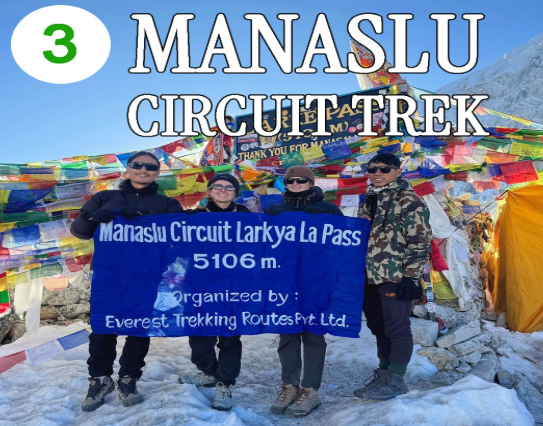Nestled in the heart of the Himalayas, Nepal stands as the ultimate destination for trekkers seeking transformative mountain experiences. This compact nation hosts an impressive array of trails that wind through landscapes ranging from subtropical forests to glaciated high-altitude deserts. Among the many remarkable routes available, four treks have earned their status as absolute must-do adventures: the Manaslu Circuit Trek, Annapurna Base Camp Trek, Langtang Valley Trek, and Everest Base Camp Trek. Each journey offers distinct characteristics, challenges, and rewards that together showcase the incredible diversity of Nepal’s trekking landscape.
Manaslu Circuit Trek: Wilderness in Its Purest Form
The Manaslu Circuit Trek stands as Nepal’s premier off-the-beaten-path adventure, circling the world’s eighth-highest mountain at 8,163 meters. This demanding expedition requires 14 to 18 days and appeals to experienced trekkers seeking authentic wilderness experiences far from tourist crowds. The remoteness and pristine character of this region create an adventure that feels like stepping back in time to an era before trekking became mainstream.
Access to the Manaslu region only became possible in 1991 when the Nepali government lifted restrictions on foreign visitors. This relatively recent opening has helped preserve the area’s natural environment and traditional cultures. Today, trekkers must obtain special restricted area permits and travel with registered guides, regulations that ensure sustainable tourism practices while limiting environmental degradation in this fragile mountain ecosystem.
The journey begins at Soti Khola and follows the powerful Budhi Gandaki River upstream through spectacular gorges where sheer cliffs rise thousands of meters on either side. The trail passes through villages inhabited by Gurung and Tibetan communities whose lifestyles have remained largely unchanged for centuries. Stone houses with prayer flags fluttering from rooftops, ancient monasteries perched on mountainsides, and locals spinning prayer wheels create an atmosphere of timeless spirituality.
As the trek progresses, Tibetan Buddhist culture becomes increasingly dominant. Massive mani walls stretch for hundreds of meters, each stone carved with Buddhist mantras by devoted pilgrims over generations. The village of Samagaon serves as a major settlement where trekkers can explore nearby glaciers and acclimatize before tackling the trek’s greatest challenge—the crossing of Larkya La Pass.
At 5,160 meters, Larkya La represents both the physical and emotional climax of the Manaslu Circuit. The ascent typically begins in predawn darkness, with trekkers navigating steep, icy terrain by headlamp. Reaching the pass at sunrise unveils one of the Himalayas’ most spectacular panoramas—Manaslu dominates the view alongside Himlung Himal, Cheo Himal, Kang Guru, and countless other peaks stretching to the horizon in every direction. The descent leads into the Marsyangdi Valley, eventually connecting with the Annapurna Circuit and providing a satisfying sense of completion to one of Asia’s great treks.
Annapurna Base Camp Trek: The Accessible Mountain Sanctuary
The Annapurna Base Camp Trek offers an exceptional blend of accessibility and spectacular mountain scenery, making it one of Nepal’s most popular moderate treks. Requiring 7 to 12 days to complete, this journey takes trekkers to 4,130 meters in the heart of the Annapurna Sanctuary—a natural amphitheater completely surrounded by towering Himalayan peaks that create a cathedral-like atmosphere of grandeur and serenity.
The trek commences in Pokhara, Nepal’s picturesque lakeside city that serves as the gateway to the Annapurna region. From here, the trail ascends through an extraordinary succession of ecosystems that demonstrate Nepal’s remarkable biodiversity. Lower elevations feature terraced farmlands where rice, millet, and vegetables grow on impossibly steep hillsides, testament to generations of agricultural innovation and hard work.
Traditional villages of the Gurung and Magar ethnic groups punctuate the route, offering trekkers opportunities for authentic cultural exchange. These communities have developed sophisticated systems for mountain living, and their warm hospitality makes the Annapurna Base Camp Trek as much a cultural journey as a physical one. Well-established teahouse lodges provide comfortable accommodations and meals throughout the route, eliminating the need for camping equipment and making this trek accessible to those new to high-altitude adventures.
The middle sections traverse magnificent rhododendron forests that explode into brilliant displays of red, pink, and white blooms during spring. These ancient forests give way to bamboo groves and eventually alpine meadows as elevation increases. The trail follows the Modi Khola gorge in its upper reaches, with the valley walls closing in dramatically before suddenly opening to reveal the sanctuary itself.
Arriving at Annapurna Base Camp feels like entering a sacred space. The surrounding peaks—Annapurna I (8,091 meters), Annapurna South, Hiunchuli, Gangapurna, and the revered Machapuchare—form a complete circle of ice-clad giants. Machapuchare, meaning “fish tail” in Nepali, remains unclimbed out of respect for its sacred status, and its distinctive double summit serves as the sanctuary’s guardian. Watching sunrise paint these massive walls in shades of gold and rose creates memories that endure long after the physical journey ends.
Langtang Valley Trek: Hidden Beauty Near the Capital
The Langtang Valley Trek represents perhaps Nepal’s best-kept secret, offering world-class mountain scenery and authentic cultural experiences just north of Kathmandu. This 7 to 10-day trek provides exceptional value for travelers with limited time, delivering genuine Himalayan adventure without requiring weeks away from home or extensive travel to remote trailheads.
Langtang National Park, Nepal’s first Himalayan conservation area, protects the valley’s remarkable biodiversity. The park shelters elusive species including red pandas, snow leopards, Himalayan tahr, and musk deer, though spotting these shy creatures requires luck and patience. More readily observable are the forests themselves—magnificent stands of oak, maple, and rhododendron that create constantly changing scenery as the trail ascends.
The valley’s inhabitants, primarily Tamang people with deep Tibetan Buddhist roots, maintain traditional lifestyles that have evolved in harmony with the mountain environment over countless generations. Their villages feature distinctive architecture with intricately carved wooden elements and colorful prayer flags that add splashes of brightness against stone walls. Monasteries, chortens, and prayer wheels encountered throughout the trek create a contemplative atmosphere that encourages reflection and mindfulness.
The trail follows the Langtang Khola river upstream, gradually climbing through progressively starker landscapes. Kyanjin Gompa at 3,870 meters serves as the valley’s main destination, offering comfortable lodges and stunning views of Langtang Lirung and surrounding peaks. From this base, trekkers can undertake day hikes to viewpoints like Kyanjin Ri and Tserko Ri for panoramic vistas, or visit the nearby glacier and cheese factory—a reminder that even in these remote mountains, life continues with practical purpose.
The 2015 earthquake struck the Langtang Valley with particular devastation. The village of Langtang was buried by a massive avalanche triggered by the quake, resulting in tragic loss of life. The community has since rebuilt with remarkable resilience, and trekking here now carries added meaning—each visitor directly supports the valley’s economic recovery and demonstrates solidarity with people who have endured tremendous hardship yet maintain their warmth and hospitality.
Everest Base Camp Trek: The World’s Most Iconic Mountain Journey
The Everest Base Camp Trek requires no introduction—it stands as the planet’s most famous trekking route, drawing adventurers from every corner of the globe. This 12 to 14-day expedition reaches 5,364 meters at base camp and offers the chance to stand at the foot of Mount Everest, the ultimate symbol of human ambition and natural majesty.
The adventure begins with an unforgettable flight into Lukla airport, consistently ranked among the world’s most dangerous yet thrilling aviation experiences. The short mountain runway ends at a cliff edge, providing immediate notice that you’ve entered a realm where ordinary rules don’t apply. From Lukla, the trail enters the Khumbu Valley, heartland of the Sherpa people whose mountaineering prowess has become synonymous with Himalayan climbing.
Namche Bazaar, the region’s bustling commercial center at 3,440 meters, serves as a critical acclimatization stop. This prosperous mountain town offers unexpected amenities including bakeries, gear shops, internet cafes, and museums documenting Everest climbing history. The Saturday market remains a vibrant tradition where traders from surrounding valleys and Tibet gather to exchange goods as they have for centuries.
Beyond Namche, the trail continues to Tengboche, home to the region’s most important monastery. Here, monks perform daily ceremonies against the backdrop of Ama Dablam, often called the “Matterhorn of the Himalayas” for its stunning symmetry. Higher still, Dingboche and Lobuche provide essential rest points as vegetation disappears and the landscape becomes increasingly harsh and beautiful.
The final section to Gorak Shep and then Everest Base Camp traverses rocky moraines and glacial debris. While base camp itself offers views of the treacherous Khumbu Icefall rather than Everest’s summit, most trekkers rise before dawn to climb Kala Patthar at 5,545 meters. This viewpoint provides the trek’s most spectacular panorama—watching the sun’s first rays illuminate Everest’s summit pyramid creates a moment of transcendent beauty that justifies every challenging step and difficult breath of the entire journey.
Conclusion
The Manaslu Circuit Trek, Annapurna Base Camp Trek, Langtang Valley Trek, and Everest Base Camp Trek collectively showcase the extraordinary range of trekking experiences available in Nepal’s Himalayas. Manaslu offers remote wilderness and authentic cultural immersion for adventurous spirits seeking paths less traveled. Annapurna delivers spectacular sanctuary scenery in a moderately challenging trek perfect for first-time high-altitude adventurers. Langtang provides accessible beauty and meaningful community connections near Kathmandu. Everest presents the ultimate bucket-list achievement and unparalleled mountaineering heritage.
Selecting among these magnificent trails depends on your fitness level, available time, previous mountain experience, and personal trekking aspirations. Yet regardless of which path calls to you, each trek promises transformative encounters with sublime natural beauty, rich Himalayan cultures, and the profound personal growth that emerges when you challenge yourself in some of Earth’s most magnificent landscapes. These journeys transcend mere physical achievement—they become pilgrimages that reveal both the majesty of our planet and the extraordinary depths of human resilience, courage, and wonder that lie dormant until awakened by the call of the mountains.
Contact Details
——————————–
Company address: Everest Trekking Routes Pvt. Ltd.
16 Khumbu, Nayabazaar, Kathmandu, Nepal
Mobile : +977-9843467921 (Rabin)
Email: info@everesttrekkingroutes.com
URL:– www.everesttrekkingroutes.com

